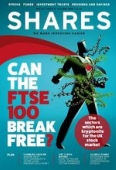Archived article
Please note that tax, investment, pension and ISA rules can change and the information and any views contained in this article may now be inaccurate.
Why the US economy might not be in as great shape as you think

On 26 April US GDP figures apparently showed an economy in much ruder health than anyone had imagined.
The headline annualised growth figure of 3.2% was significantly ahead of the 2.3% forecast by economists and the best first quarter performance since 2015. The positive surprise helped drive US equities to new record highs; job done, move along, nothing else to see here, right?
Well, not quite. This was definitely an example where there is a strong case for looking beyond the headlines to examine what lay behind the growth.
For the most part the answer is highways investment, a sharp rise in inventories and a rise in net exports. All three of these factors look temporary.
And some observers have pointed out that the rise in inventories in the first quarter could actually be a significant headwind in the second quarter if the build-up in stockpiled goods leads to reduced demand in the manufacturing sector.
The US remains a consumer-driven economy. Personal consumption accounted for nearly 70% of GDP in 2018.
Here the news was much less positive. Consumer spending was up just 1.2% – perhaps unsurprising given the impact of the shutdown in Washington.
There have been signs recently that spending is beginning to pick up, notably in robust March retail sales and personal spending figures, however business investment remains weak and the housing market contracted for the fourth quarter in a row in the first three months of 2019.
THE DEVIL IS IN THE DETAIL
Rupert Thompson, head of research at wealth manager Kingswood, says: ‘The equity rally has been given added fuel in recent weeks by signs that global growth is starting to bottom out.
‘And on first sight, US Q1 GDP numbers were very reassuring on this front with growth picking up. The details, however, were distinctly less impressive with underlying domestic demand growing only 1.3%, the slowest rate since 2015.’
Like the US, China’s economy also did better than expected in the first quarter with growth of 6.4%. But in this case the concerted stimulus efforts pursued by the Chinese authorities – areas like infrastructure spending, tax cuts and the central bank boosting the money supply – were seen as playing a big part. And even then, there are serious question marks about the credibility of the numbers themselves.
That’s not to say all is doom and gloom, clearly it is better to see key economic data come in ahead of forecasts, but it is important investors do not become complacent and assume global growth concerns have evaporated overnight.
Important information:
These articles are provided by Shares magazine which is published by AJ Bell Media, a part of AJ Bell. Shares is not written by AJ Bell.
Shares is provided for your general information and use and is not a personal recommendation to invest. It is not intended to be relied upon by you in making or not making any investment decisions. The investments referred to in these articles will not be suitable for all investors. If in doubt please seek appropriate independent financial advice.
Investors acting on the information in these articles do so at their own risk and AJ Bell Media and its staff do not accept liability for losses suffered by investors as a result of their investment decisions.
 magazine
magazine









